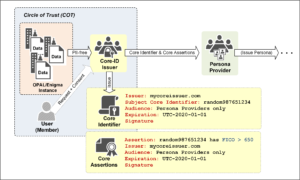Continuing from the previous post (Part I of the Core Identity series), the goal of a Core Identity Issuer (CoreID Issuer) is to collate sufficient data – aggregate data and non-PII data — from members of a given Circle of Trust in order to create a Core Identity and Core Identifier for a given user (see Figure).
The Issuer performs this task as a trusted member of the Circle of Trust, governed by rules of operations (i.e. legal contract) and with the consent of the user. Architectures and techniques such as MIT OPAL/Enigma can be used here in order for the CoreID Issuer to obtain privacy-preserving aggregate data from the various sources who are members of the Circle of Trust.
The goals of the Core-ID Issuer within a Circle of Trust are as follows:
- Onboard a member-user: The Issuer’s primary function is to on-board users who are known to the CoT community, and who have requested and consented to the creation of a Core Identity.
- Collate PII-free data into a Core Identity: The Issuer obtains aggregate data and other PII-free data regarding the user from members of the CoT. This becomes the core identity for the user, which is retained by the Issuer for the duration selected by the user. The Issuer must keep the core identity as secret, accessible only to the user.
- Generate Core Identifier (unlinkable): For a given user and their core identity, the Issuer generates a core identifier (e.g. random number) that must be unlikable to the core identity. Note that a core identifier must not be used in a transaction. The core identifier value may be contained as a signed certificate or other signed data structure, with the Persona Provider as its intended audience (see Figure).
- Issue Core Assertions regarding the Core Identifier: The purpose of the Issuer generating a core identifier is to allow PII-free core-assertions regarding the user to be created. These signed core assertions must retain the privacy of the user, and must declare assertions about the core identifier.
- Interface with Persona Providers: The Issuer’s main audience is the Persona Provider, who must operate with the Issuer under legal trust framework that calls-out user privacy as a strict requirement. The Issuer must make available the necessary issuance end-points (i.e. APIs) as well as validation end-points to the Persona Provider. In some cases, from an operational deployment view the Issuer and Persona Provider may be co-located or even tightly coupled under the same provider entity, although the functional difference and boundaries are clear.



















